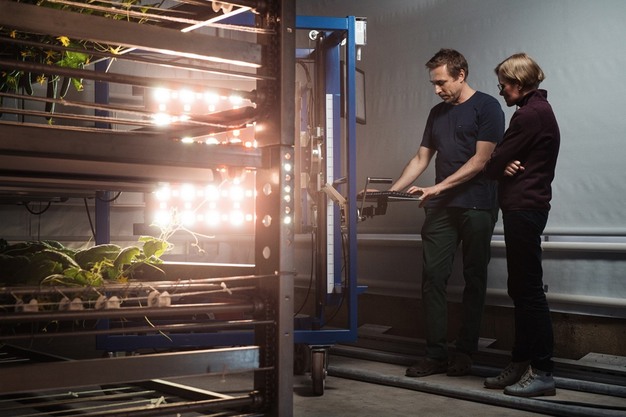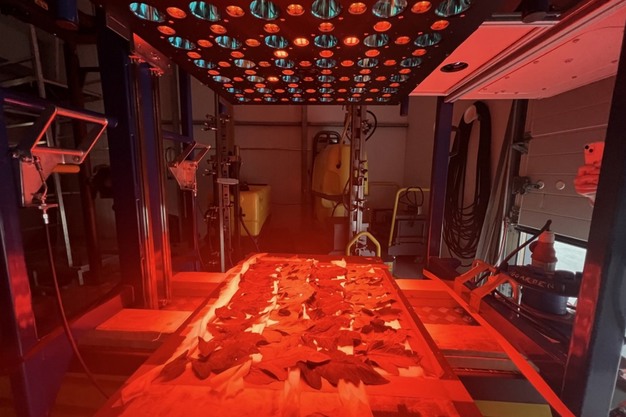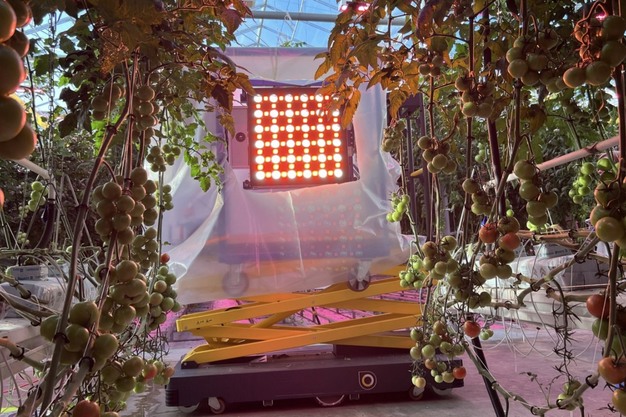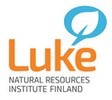"This is a state-of-the-art mobile platform of its kind," says Tuomo Laine, Specialist and Doctoral Researcher at Luke. "There are similar integrated phenotyping platforms elsewhere, but this one moves (with us) into production environments."
Tuomo and his colleagues, Alexey Shapiguzov, Satu Engström, and Titta Kotilainen in Finland, are experimenting with a mobile phenotyping platform that's helping decode the language of plants in situ. Developed by Senior Scientist Alexey Shapiguzov at the Natural Resources Institute Finland (Luke) together with Photon System Instruments (PSI, Drásov, Czech Republic) and SMO (Eeklo, Belgium), this prototype system brings the imaging lab directly into greenhouses, offering novel ways to monitor plant health, physiology, and efficiency with cutting-edge imaging technologies.
Arriving at Luke's horticultural research station in Piikkiö in the summer of 2023, the system has already been deployed in Finnish greenhouses year-round, helping both researchers and commercial growers understand how plants respond to light, stress, and environmental conditions in real-world settings.
 © Jarkko Mikkonen
© Jarkko Mikkonen
Alexey Shapiguzov and Titta Kotilainen setting up photosynthesis monitoring in horizontally grown cucumber.
Moving forward with plant imaging
Tuomo shares that the mobile phenotyping system integrates three high-precision imaging techniques. A 12.36-megapixel RGB camera captures detailed images of plant morphology and color. These images allow researchers to monitor growth dynamics, detect discoloration, evaluate plant fitness, and analyze changes that indicate visible stress.
At the same time, a thermal imaging unit, a InfraTec camera with 20 mK thermal sensitivity and IR resolution 1024 x 768 pixels, measures leaf and canopy temperatures to reveal patterns in transpiration, stomatal conductance, and water use efficiency. ''Through this, researchers can detect early signs of water deficit, heat or drought stress, and even biotic stress and diseases before visual symptoms emerge.''
According to him, perhaps most advanced is the chlorophyll fluorescence imaging module, which features the FluorCam with two interchangeable cameras both built by PSI: TOMI-2, high resolution camera, used for classical PAM (pulse amplitude modulation) analyses, and TOMI-3, an ultrafast camera that supports high framerate measurements of flash-induced fluorescence. These tools give researchers a direct look into how light energy flows through the plant's photosynthetic apparatus, revealing how efficiently plants convert light into biochemical energy.
The platform can run a wide range of specialized assays, including light response curves, quenching analyses, measurements of photosynthetic state transitions, stress-induced photoinhibition, and O(J)IP imaging, which provides highly sensitive data on acclimation processes within the photosynthetic machinery and the stress levels.
"The integrated version of TOMI-3 technology alone is a distinctive innovation," Tuomo explains. "Our new mobile system allows us to run ultrafast flash-induced imaging, the means for advanced "fingerprinting" of photosynthesis, while moving around as we like."
 © Alexey Shapiguzov
© Alexey Shapiguzov
Unique sideways imaging enables in situ analysis of photosynthetic light reactions within production environments.
Bridging research and practice
Luke has already worked closely with Finnish commercial greenhouses to test and validate the phenotyping platform on crops like tomatoes and cucumbers, climbing with greenhouse lifts to capture photosynthesis at top canopy level. These in situ measurements complement analyses in detached leaves, which are not always accurate, particularly in plants with high tissue water potential like cucumbers.
"At first we climbed to top canopy with the system, and it weighs over 300 kilos by the way," he says. "Luckily, in tomatoes detached fresh leaves gave us very similar data, which made our life much easier in practice."
The system's flexibility extends even further. Its modular design allows for sideways imaging, making it useful for tall crops like raspberries, which Laine is studying as part of his PhD research. "Sideways imaging of chlorophyl fluorescence is another unique feature of the platform," says Laine. The team discovered that photosynthetic functions can differ very substantially among different raspberry varieties, despite their similar growth habits. This finding highlights the platform's potential in breeding programs, where understanding a plant's physiological performance can be just as important as appearance.
 © Titta Kotilainen
© Titta Kotilainen
In tomato, freshly detached leaves placed on a moist surface exhibited photosynthetic activity very similar to that of leaves on intact plants, enabling shortcuts in their analyses
Real-World Benefits for Growers and Breeders
The value of this system isn't limited to researchers. It also offers immense practical benefit to plant breeders and growers. In breeding trials, the Luke team has been able to identify variations in photosynthetic efficiency among different genotypes, for instance in raspberry, faba bean, oat and potato. They've also used thermal and fluorescence imaging to compare how different plant varieties respond to various environmental treatments, such as excessive light or waterlogging.
Commercial greenhouse growers, especially in Finland's challenging seasonal climate, have also found value. The team collaborates with growers who want to experiment with different LED light spectra and lighting scenarios in their greenhouses. This setup allows the researchers to compare how different lighting conditions affect plant stress, growth, and resource use. The results may help growers optimize light levels and improve energy efficiency, which has become increasingly important due to rising and fluctuating energy costs.
"In Finnish dark winter, plant behavior is completely different from summer," says Laine. "Our aim as a state research institute is to help Finnish growers make data-driven decisions about their greenhouse environment and dynamic light schedules—especially important given today's energy costs."
 © LUKE
© LUKE
Looking toward commercialization
At present, Luke offers the phenotyping platform as part of collaborative research projects, working closely with PSI to continue refining and improving the system. The platform remains a prototype, but commercial version could eventually be beneficial to a wider user base.
"We're still learning how to best utilize our imaging platform," Laine reflects, "but it already provides a lot of information about how plants adapt to different growing environments—and how we could help growers with their efficiency and sustainability targets."
For more information:
Natural Resources Institute Finland (Luke)
Tuomo Laine, Specialist & Doctoral Researcher: tuomolaine profile
Alexey Shapiguzov, Senior Scientist: alexeyshapiguzov profile
Satu Engström, Scientist & Doctoral Researcher: satuengstrom profile
Titta Kotilainen, Research Professor: tittakotilainen profile
www.luke.fi










